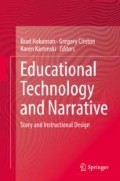Abstract
The narrative qualities of a design presentation and subsequent critique comprise a design argument, distilling designers’ rationale for their design, rooted in their process. In this paper, I analyze two consecutive design presentations from an introductory undergraduate human-centered design studio, documenting the argumentation structures students rely upon when “selling” their design. Dominant argumentation structures of these presentation events are described and related to narrative in a human-centered design context.
Access this chapter
Tax calculation will be finalised at checkout
Purchases are for personal use only
References
Blevis, E., & Siegel, M. (2005). The explanation for design explanations. In 11th international conference on human-computer interaction: Interaction design education and research: Current and future trends.
Boling, E., & Gray, C. M. (2015). Designerly tools, sketching, and instructional designers and the guarantors of design. In B. Hokanson, G. Clinton, & M. W. Tracey (Eds.), The design of learning experience: Creating the future of educational technology (pp. 109–126). Cham, Switzerland: Springer. https://doi.org/10.1007/978-3-319-16504-2_8.
Boling, E., Siegel, M. A., Smith, K. M., & Parrish, P. (2013). Student goes on a journey; stranger rides into the classroom: Narratives and the instructor in the design studio. Art, Design & Communication in Higher Education, 12(2), 179–194. https://doi.org/10.1386/adch.12.2.179_1.
Cooper, A. (2004). The inmates are running the asylum. Indianapolis, IN: Pearson Education.
Dalsgaard, P., Dindler, C., & Fritsch, J. (2013). Design argumentation in academic design education. In Proceedings of Nordes (Vol. 1, pp. 426–429). Copenhagen, Denmark/Mälmo, Sweden.
Dannels, D. P. (2005). Performing tribal rituals: A genre analysis of crits in design studios. Communication Education, 54(2), 136–160.
Dannels, D., Gaffney, A., & Martin, K. (2008). Beyond content, deeper than delivery: What critique feedback reveals about communication expectations in design education. International Journal for the Scholarship of Teaching and Learning, 2(2), 1–16.
Dewey, J. (1938/2005). Art as experience. New York: Perigee Trade.
Duschl, R. A., & Osborne, J. (2002). Supporting and promoting argumentation discourse in science education. Studies in Science Education, 38, 39–72.
Erickson, T. (1996). Design as storytelling. Interactions, 3(4), 30–35. https://doi.org/10.1145/234813.234817.
Fischer, G., Lemke, A. C., McCall, R., & Morch, A. I. (1991). Making argumentation serve design. Human-Computer Interaction, 6(3–4), 393–419.
Gray, C. M. (2013). Discursive structures of informal critique in an HCI design studio. In Nordes 2013: Experiments in design research (pp. 110–118). Copenhagen, Denmark/Malmö, Sweden.
Gray, C. M. (2014). Evolution of design competence in UX practice. In CHI’14: Proceedings of the SIGCHI conference on human factors in computing systems (pp. 1645–2654). New York: ACM Press. https://doi.org/10.1145/2556288.2557264.
Klebesadel, H., & Kornetsky, L. (2009). Critique as signature pedagogy in the arts. In R. Gurung, N. Chick, & A. Haynie (Eds.), Exploring signature pedagogies: Approaches to teaching disciplinary habits of mind (pp. 99–120). Sterling, VA: Stylus Publishing.
Martin, B., & Hanington, B. (2012). Universal methods of design: 100 ways to research complex problems, develop innovative ideas, and design effective solutions. Beverly, MA: Rockport Publishers.
Morton, J., & O’Brien, D. (2006). Selling your design: Oral communication pedagogy in design education. Communication Education, 54(1), 6–19. https://doi.org/10.1080/03634520500076885.
McCarthy, J., & Wright, J. (2004). Technology as experience. Cambridge, MA: MIT Press.
Nelson, H. G., & Stolterman, E. (2012). The design way: Intentional change in an unpredictable world (2nd ed.). Cambridge, MA: MIT Press.
Oak, A. (1998). Assessment and understanding: An analysis of talk in the design studio critique. In Engendering communication—Proceedings from the fifth Berkeley women and language conference. Berkeley, CA: University of California.
Parrish, P. (2014). Designing for the half-known world: Lessons for instructional designers from the craft of narrative fiction. In B. Hokanson & A. Gibbons (Eds.), Design in educational technology (pp. 261–270). Cham, Switzerland: Springer. https://doi.org/10.1007/978-3-319-00927-8_15.
Quesenbery, W., & Brooks, K. (2010). Storytelling for user experience: Crafting stories for better design. Brooklyn, NY: Rosenfeld Media.
Smith, K. M., & Boling, E. (2009). What do we make of design? Design as a concept in educational technology. Educational Technology, 49(4), 3–17.
Author information
Authors and Affiliations
Corresponding author
Editor information
Editors and Affiliations
Rights and permissions
Copyright information
© 2018 Springer International Publishing AG
About this chapter
Cite this chapter
Gray, C.M. (2018). Narrative Qualities of Design Argumentation. In: Hokanson, B., Clinton, G., Kaminski, K. (eds) Educational Technology and Narrative. Springer, Cham. https://doi.org/10.1007/978-3-319-69914-1_5
Download citation
DOI: https://doi.org/10.1007/978-3-319-69914-1_5
Published:
Publisher Name: Springer, Cham
Print ISBN: 978-3-319-69913-4
Online ISBN: 978-3-319-69914-1
eBook Packages: EducationEducation (R0)

